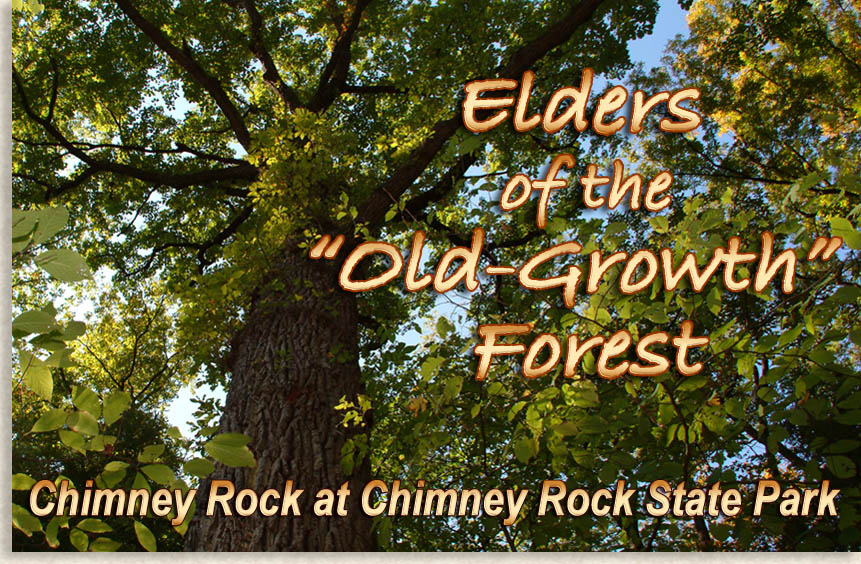
They stand tall in stillness and silence at the very edge of dawn anticipating a call to service that awakens them each day. The small delicate winged inhabitants residing within their sturdy and spacious limbs begin to sing their morning songs just before the first light of day. Their voices blend in unison resounding as if they were part of a 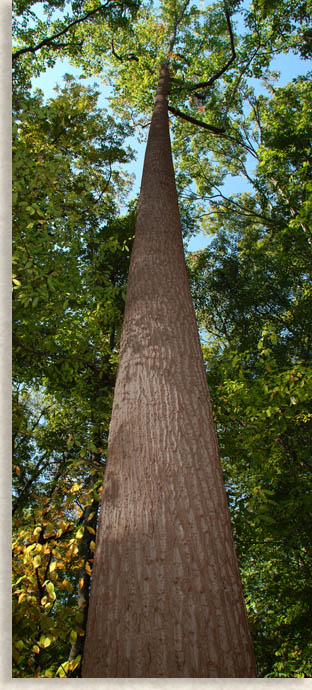 wilderness choir held within a cathedral forest of giant trees, all the while fluttering about in excitement and reverence of a new rising sun.
wilderness choir held within a cathedral forest of giant trees, all the while fluttering about in excitement and reverence of a new rising sun.
The giant elder trees of this forest have stood here for centuries facing the east eagerly awaiting the summons of the glory they have known since they were saplings upon the forest floor. As the great ball of fire breaks the horizon their branches and leaves begin to awaken as they eagerly reach towards the eastern sky. While the sun journeys across the heavens along its daily procession, these elders of the ancient forest bask in the radiant glory of the mysteries of life, finding themselves continually drawn ever higher to the glory for which they were created.
In the evening the forest elders along with their younger family members rest under the shade of their own great canopies, patiently toiling away day after day, growing taller year after year. Another day’s work done, another inch closer they have grown towards the sun. The golden rings they carry within their mighty trunks tell the extraordinary story of their life’s journey, their record of wisdom and the conditions of the world around them. Their bold beauty and great size seize the stage of the forest floor, their presence demands due attention. They are the elders of the “Old-Growth” Forest, the Giants of Chimney Rock at Chimney Rock State Park.
As an organic life force trees have survived world catastrophes, out lived the dinosaurs, outlasted the ice age and survived great floods to be the oldest and greatest in stature as an organic life form ever cycling along our aging planet. As the largest and one of the most beautiful plant species on earth, mature trees command recognition and respect as an essential natural resource for our personal survival, providing needed wood products for various use while creating the vital oxygen that feeds our grateful lungs. The greatest enemies of these giant forest species have been, drought, wind, lightning, forest fires and disease along with the disastrous clear-cut logging saws of too many environmentally uncaring timber barons of old.
Thanks to George W. Vanderbilt of Biltmore Estate, forest management began to take root around the turn of the 20th century, setting a stage for the National and State Forests we enjoy today.
The mighty elders of the forest, those ancient tree stands that have survived throughout the Blue Ridge Smoky Mountains, are counted amongst the most precious and venerable remnants of the old-growth forest of the eastern United States. Wooden giants fortunate enough to have escaped the logging saws around the turn of the 20th century now reside under the proper care of forest management.
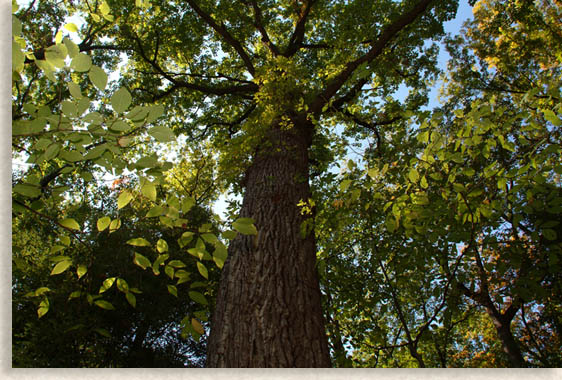 Along the eastern wall of the great temple mount of Chimney Rock at Chimney Rock State Park stands a natural garden terrace, a place of solitude and order. Here within this quiet outer edge of the natural stone temple mount live the “Elders,” the ancient ones of the mountain forest. The temple mount at Chimney Rock is formed of massive stone outcroppings and exposed mountain rock face shaped by wind and water, a natural stone monument where plant life springs from its cracks and crevices, adhering itself to the thin soil along the jagged rocks from its tabletop summit to its lush lower valley floor. Yet it is within the soil covered terrace garden along the temple mounts lower eastern forest that life has experienced abundance and continual uninterrupted growth for centuries.
Along the eastern wall of the great temple mount of Chimney Rock at Chimney Rock State Park stands a natural garden terrace, a place of solitude and order. Here within this quiet outer edge of the natural stone temple mount live the “Elders,” the ancient ones of the mountain forest. The temple mount at Chimney Rock is formed of massive stone outcroppings and exposed mountain rock face shaped by wind and water, a natural stone monument where plant life springs from its cracks and crevices, adhering itself to the thin soil along the jagged rocks from its tabletop summit to its lush lower valley floor. Yet it is within the soil covered terrace garden along the temple mounts lower eastern forest that life has experienced abundance and continual uninterrupted growth for centuries.
Few people know of this hidden forest of elder trees, known as Chimney Rock’s Old-Growth Forest. Though gigantic and strong in stature this terrace of ancient trees are fragile within their own surroundings and for now must remain isolated from the masses like the inner sanctum of a revered site.
Residing in natural isolation from the rest of the park activities at Chimney Rock State Park, the towering elders of the parkland’s rare old-growth forest offer an example (though restricted access) of one the finest old-growth tree stands in all the Southern Appalachian Mountains. It is also one of the park’s best-kept secrets in order to continue to preserve their longevity at this present time.
Here within this enchanted and sacred forest is an ongoing effort by the staff of Chimney Rock State Park to preserve and conserve the natural order of this precious setting. The park’s cherished old-growth forest is currently not opened to the public due to the sensitivity of its plant species along the forest floor of this healthy yet elderly tree stand.
Acquiring the privilege of touring Chimney Rock’s Old-Growth Forest falls under the direction of an experienced and informative Chimney Rock State Park educational guide. Some guided hiking tours can be pre-arranged well in advance through the staff at Chimney Rock at Chimney Rock State Park.
Within this ancient tree stand you’ll find yourself learning the language of the forest while communing amongst the giants of these sacred woodlands. Hickory, Chestnut Oaks, Northern Red Oaks, Tulip Poplars and Black Locust support the immense canopy that covers this ancient hardwood forest. Life has seen little change within this enchanted forest over the past several centuries. Escaping the logging saws of the late 19th and early 20th centuries has set this forest aside for a more secure future. Some of these giant elder trees exceed 120-feet tall and over 13-feet in circumference.
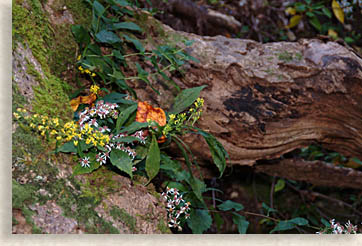 In the underworld below their great height and large lumbering branches, live an ongoing cycle of flora and fauna. From its forest floor, plant life springs forth under the protective shade of the ancient forest with wildflowers blooming from early spring and throughout the late summer before the leaves of the great canopy respond to the call of autumn’s chill and fall from the sky, leaving a thick protective carpet of colored leaves covering the forest floor. It is only after the great shedding of the autumn season does the forest open its columned cathedral to the sky above for a long winter’s rest.
In the underworld below their great height and large lumbering branches, live an ongoing cycle of flora and fauna. From its forest floor, plant life springs forth under the protective shade of the ancient forest with wildflowers blooming from early spring and throughout the late summer before the leaves of the great canopy respond to the call of autumn’s chill and fall from the sky, leaving a thick protective carpet of colored leaves covering the forest floor. It is only after the great shedding of the autumn season does the forest open its columned cathedral to the sky above for a long winter’s rest.
Scurrying about the old-growth forest floor and climbing the trunks of the great trees are the fauna residents of the forest. Living playing and surviving within the cathedral forest are a variety of birds, chipmunks, squirrels and four legged reptiles hustling about for food. Wild rabbits and other small furry critters move about the forest floor cautiously while keeping a sharp look out for the mighty birds of prey or an occasional sly fox with a serious appetite. The songs of the winged residents within this sacred forest are often faint to the ear. The exceeding heights of the ancient tree limbs cause their voices to extend high beyond our mortal sense of sound. Maybe their songs were only meant to entertain the great elders of the forest within the private upper chambers, a choir like music resounding on a higher level under an outdoor cathedral of tall trees, whose ever expanding limbs continue to stretch across the sky.
It is the height and distance apart of these great trees along with the heavy coverage of their high canopy that typically signifies the presence of an old growth forest. To further clarify what the recognizable difference between a “virgin forest” and an “old-growth forest,” I turned to Chimney Rock’s staff naturalist Ronald Lance in order to enlighten my understanding.
Ron replied, “The term “old-growth forest” means different things to different people, particularly in land management administrators, and its definition is as varied as its appearance from site to site. There is sometimes an affiliation based purely on age of the canopy (over 100 years, 150 years, etc.), often allied with the presence of large trees, but tree size attained after an arbitrary number of years is environmentally governed. Harsh growing conditions may yield dwarfish trees that are 100 years old, while poplars might be relative giants after only 40 years on an ideal site.
A more applicable description of "old-growth", to me, takes in the entire dynamics of a forest stand. There are old trees (at least 100 years of age), there are fallen trees, and there are young trees, all of which correspond in the same species mixes. The rather out-dated term "climax forest" was once popularly used to define a forest which appears self-sustaining; the canopy tree species have their progeny underneath (called "advance regeneration"), and when an old tree falls, those progeny compete for dominance in the gap, but few new species come in to change the overall species mix of the canopy. This schedule changes when large blow-downs or logging occurs; then wind-blown seeds of tulip tree, red maple and black birch (in this region) infiltrate by the thousands and can overwhelm by their faster growth the slower-growing oaks and hickories. As man continues to cut merchantable-sized hardwood timber that has re-grown in 30-80 year rotations, the stumps re-sprout and outgrow most seedlings, so the changes from traditional species on a site to faster-growing species that have come in more recently continues to shift our forest compositions.
At one time, periodic ground fires also helped with the climax forest in some sites, because it pruned back under-story shrubby growth like laurel, rhododendron, and other ericads providing light for growth of the potential climax tree seedlings. With extended protection from all fires, these shrubby thickets become so extensive that few tree seedlings can survive their shade; hence more problems with canopy species regeneration. Also a pronounced change in the last 100 years are introduced diseases, pests, and exotic plants- these have drastically changed the long-stable natural scheme of our forests.
Chimney Rock's old growth stand of Montane Oak-Hickory forest is recognizable because of several traits. First, the canopy trees have had time to develop broad crowns and tall heights, in addition to girth, from over 150 years of growth. This forest is uneven-aged, as under the largest canopy trees there are scattered subordinates ranging from sub-canopy to sapling to seedling. An important trait is that these subordinates include species that are dominant in the canopy. There is ample light for these recruits to survive and wait for a prospective turn of their own, since they are by nature shade-tolerant in their early life and the high crowns of the old trees allow plenty of light to angle through. Less shade tolerant species gradually expire under the crowns of dominants. Each layer of foliage, however, reduces light availability beneath; when the under-story is dense, the forest floor may be dark and have less botanical diversity. A regenerating forest therefore has more foliage closer to the ground and a more shaded forest floor (and less herbs) than an old, tall forest. Unless, of course, one is looking at a particular place in an old forest where a fallen tree has allowed a flood of light and a corresponding flush of undergrowth. Thickets of laurel and rhododendron signify lack of fire incidence and this is very noticeable in the Park.”
“Thanks Ron this is valuable information in comprehending the unique diversity in the developmental process of our natural forest.”
Though the mighty Elders stand big and tall, it is commonly known that “what goes up must eventually come down.” Wherever you find a break in the great canopy of the old-growth forest it is most likely a result of a fallen elder. Within these openings, saplings emerge from seedlings exposing their sprouting leaves to the rays of the sun in hope that one day they may also join the ranks of the great “Elders” themselves.
The unfortunate fallen elders do in their own way continue to carry on the legacy of the ancient tree stands notoriety. The former North Carolina State Champion, a “sand hickory,” lies here along the forest floor of Chimney Rock State Park. The champ now measures at 110-feet in length and 12 feet in circumference now that it rest upon its side. Though fallen in the last decade due to a strong wind, this great elder of the forest has yet to entirely give up its ghost. Once standing higher than all the elders in Chimney Rock’s Old-Growth Forest, this revered elder champion of the temple mount’s forested terrace, rests quietly, now stretched forth for all to see its might, width and length while providing a new home for lichens, moss, fungi and even delicate wildflowers along with burrowing critters, insects, nesting woodpeckers and some of the parks more than 100 bird species. Squirrels have also moved in to use its present vertical limbs for nests and refuge now that its mighty limbs are closer to the ground.
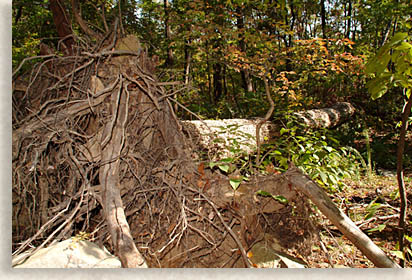 |
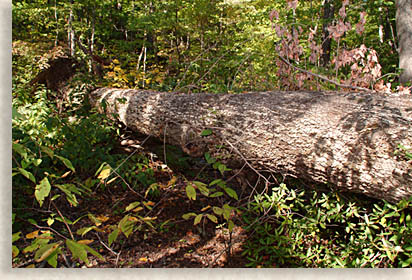 |
This champion “Sand Hickory” along with other fallen former giants of Chimney Rock’s Old-Growth Forest, offer a unique display of their personal grandeur lying on their sides with their massive tree trunks stretched before you and their incredible lengths running across the horizon. From this vantage point, you can walk the full length of these fallen giants from their once upper branches to their shooting array of roots that once supported their towering weight. Today’s Elder Champion of Chimney Rock’s Old-Growth forest is its Chestnut Oak approximately 300-years old, 120-feet plus tall, 13 feet 2 inches in circumference and the good news, its still growing and aging with dignity.
Trees within the southern Blue Ridge Mountains’ Old-Growth Forests can be well over 400-years old, yet scattered along the floor of these old-growth forest are much older residents, the enormous “Graybacks.” Graybacks are boulders that have tumbled down from the upper regions of the old temple mount at Chimney Rock State Park. These mega-stones display themselves as permanent sentries of the old-growth forest and will remain as such forever, keeping time and knowledge of their eternal resting place. In a sense these “Graybacks” mock the mere youth of the elder trees, their presence is older than dirt itself.
The elder trees of Chimney Rock’s Old-Growth Forest must be held in reverence and protected so that the natural life of the old forest can continue to grow on as it always has since the glorious birth of the first trees on earth.
The Highlander
Visit Chimney Rock Park's website
![]()
Sign
up for the Blue Ridge Highlander Newsletter, Messages from the Mountains
to find out first about our new feature stories, road trips and special offers
Your e-mail addresses will not be sold or given away to anyone.
Privacy
Policy
Interested in your business being on the Highlander, click here...
Let our visitors tell you about the Highlander...
Click the feathers to go to the Highlander site
map...

